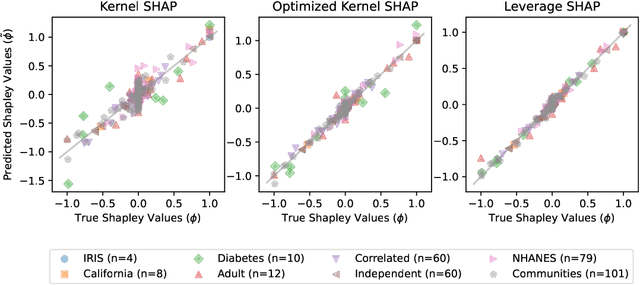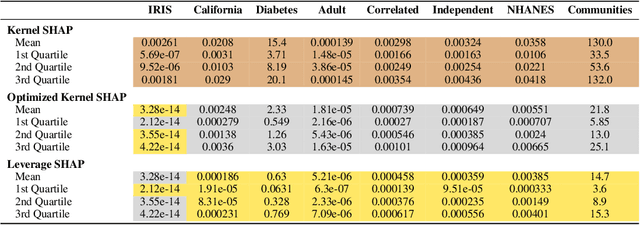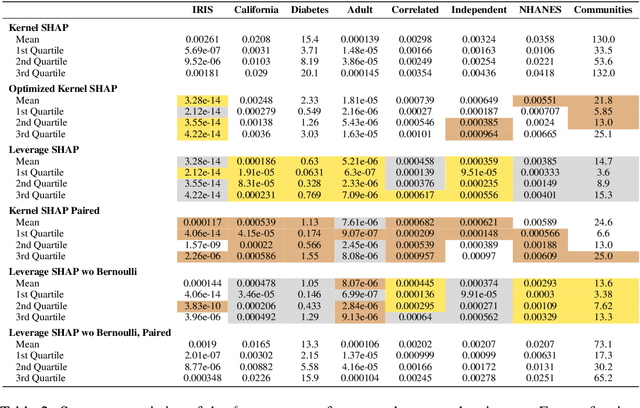R. Teal Witter
Regression-adjusted Monte Carlo Estimators for Shapley Values and Probabilistic Values
Jun 13, 2025Abstract:With origins in game theory, probabilistic values like Shapley values, Banzhaf values, and semi-values have emerged as a central tool in explainable AI. They are used for feature attribution, data attribution, data valuation, and more. Since all of these values require exponential time to compute exactly, research has focused on efficient approximation methods using two techniques: Monte Carlo sampling and linear regression formulations. In this work, we present a new way of combining both of these techniques. Our approach is more flexible than prior algorithms, allowing for linear regression to be replaced with any function family whose probabilistic values can be computed efficiently. This allows us to harness the accuracy of tree-based models like XGBoost, while still producing unbiased estimates. From experiments across eight datasets, we find that our methods give state-of-the-art performance for estimating probabilistic values. For Shapley values, the error of our methods can be $6.5\times$ lower than Permutation SHAP (the most popular Monte Carlo method), $3.8\times$ lower than Kernel SHAP (the most popular linear regression method), and $2.6\times$ lower than Leverage SHAP (the prior state-of-the-art Shapley value estimator). For more general probabilistic values, we can obtain error $215\times$ lower than the best estimator from prior work.
SEAL: Semantic Aware Image Watermarking
Mar 15, 2025Abstract:Generative models have rapidly evolved to generate realistic outputs. However, their synthetic outputs increasingly challenge the clear distinction between natural and AI-generated content, necessitating robust watermarking techniques. Watermarks are typically expected to preserve the integrity of the target image, withstand removal attempts, and prevent unauthorized replication onto unrelated images. To address this need, recent methods embed persistent watermarks into images produced by diffusion models using the initial noise. Yet, to do so, they either distort the distribution of generated images or rely on searching through a long dictionary of used keys for detection. In this paper, we propose a novel watermarking method that embeds semantic information about the generated image directly into the watermark, enabling a distortion-free watermark that can be verified without requiring a database of key patterns. Instead, the key pattern can be inferred from the semantic embedding of the image using locality-sensitive hashing. Furthermore, conditioning the watermark detection on the original image content improves robustness against forgery attacks. To demonstrate that, we consider two largely overlooked attack strategies: (i) an attacker extracting the initial noise and generating a novel image with the same pattern; (ii) an attacker inserting an unrelated (potentially harmful) object into a watermarked image, possibly while preserving the watermark. We empirically validate our method's increased robustness to these attacks. Taken together, our results suggest that content-aware watermarks can mitigate risks arising from image-generative models.
Hidden in the Noise: Two-Stage Robust Watermarking for Images
Dec 05, 2024Abstract:As the quality of image generators continues to improve, deepfakes become a topic of considerable societal debate. Image watermarking allows responsible model owners to detect and label their AI-generated content, which can mitigate the harm. Yet, current state-of-the-art methods in image watermarking remain vulnerable to forgery and removal attacks. This vulnerability occurs in part because watermarks distort the distribution of generated images, unintentionally revealing information about the watermarking techniques. In this work, we first demonstrate a distortion-free watermarking method for images, based on a diffusion model's initial noise. However, detecting the watermark requires comparing the initial noise reconstructed for an image to all previously used initial noises. To mitigate these issues, we propose a two-stage watermarking framework for efficient detection. During generation, we augment the initial noise with generated Fourier patterns to embed information about the group of initial noises we used. For detection, we (i) retrieve the relevant group of noises, and (ii) search within the given group for an initial noise that might match our image. This watermarking approach achieves state-of-the-art robustness to forgery and removal against a large battery of attacks.
Kernel Banzhaf: A Fast and Robust Estimator for Banzhaf Values
Oct 10, 2024



Abstract:Banzhaf values offer a simple and interpretable alternative to the widely-used Shapley values. We introduce Kernel Banzhaf, a novel algorithm inspired by KernelSHAP, that leverages an elegant connection between Banzhaf values and linear regression. Through extensive experiments on feature attribution tasks, we demonstrate that Kernel Banzhaf substantially outperforms other algorithms for estimating Banzhaf values in both sample efficiency and robustness to noise. Furthermore, we prove theoretical guarantees on the algorithm's performance, establishing Kernel Banzhaf as a valuable tool for interpretable machine learning.
FairlyUncertain: A Comprehensive Benchmark of Uncertainty in Algorithmic Fairness
Oct 02, 2024



Abstract:Fair predictive algorithms hinge on both equality and trust, yet inherent uncertainty in real-world data challenges our ability to make consistent, fair, and calibrated decisions. While fairly managing predictive error has been extensively explored, some recent work has begun to address the challenge of fairly accounting for irreducible prediction uncertainty. However, a clear taxonomy and well-specified objectives for integrating uncertainty into fairness remains undefined. We address this gap by introducing FairlyUncertain, an axiomatic benchmark for evaluating uncertainty estimates in fairness. Our benchmark posits that fair predictive uncertainty estimates should be consistent across learning pipelines and calibrated to observed randomness. Through extensive experiments on ten popular fairness datasets, our evaluation reveals: (1) A theoretically justified and simple method for estimating uncertainty in binary settings is more consistent and calibrated than prior work; (2) Abstaining from binary predictions, even with improved uncertainty estimates, reduces error but does not alleviate outcome imbalances between demographic groups; (3) Incorporating consistent and calibrated uncertainty estimates in regression tasks improves fairness without any explicit fairness interventions. Additionally, our benchmark package is designed to be extensible and open-source, to grow with the field. By providing a standardized framework for assessing the interplay between uncertainty and fairness, FairlyUncertain paves the way for more equitable and trustworthy machine learning practices.
Provably Accurate Shapley Value Estimation via Leverage Score Sampling
Oct 02, 2024



Abstract:Originally introduced in game theory, Shapley values have emerged as a central tool in explainable machine learning, where they are used to attribute model predictions to specific input features. However, computing Shapley values exactly is expensive: for a general model with $n$ features, $O(2^n)$ model evaluations are necessary. To address this issue, approximation algorithms are widely used. One of the most popular is the Kernel SHAP algorithm, which is model agnostic and remarkably effective in practice. However, to the best of our knowledge, Kernel SHAP has no strong non-asymptotic complexity guarantees. We address this issue by introducing Leverage SHAP, a light-weight modification of Kernel SHAP that provides provably accurate Shapley value estimates with just $O(n\log n)$ model evaluations. Our approach takes advantage of a connection between Shapley value estimation and agnostic active learning by employing leverage score sampling, a powerful regression tool. Beyond theoretical guarantees, we show that Leverage SHAP consistently outperforms even the highly optimized implementation of Kernel SHAP available in the ubiquitous SHAP library [Lundberg & Lee, 2017].
Benchmarking Estimators for Natural Experiments: A Novel Dataset and a Doubly Robust Algorithm
Sep 06, 2024



Abstract:Estimating the effect of treatments from natural experiments, where treatments are pre-assigned, is an important and well-studied problem. We introduce a novel natural experiment dataset obtained from an early childhood literacy nonprofit. Surprisingly, applying over 20 established estimators to the dataset produces inconsistent results in evaluating the nonprofit's efficacy. To address this, we create a benchmark to evaluate estimator accuracy using synthetic outcomes, whose design was guided by domain experts. The benchmark extensively explores performance as real world conditions like sample size, treatment correlation, and propensity score accuracy vary. Based on our benchmark, we observe that the class of doubly robust treatment effect estimators, which are based on simple and intuitive regression adjustment, generally outperform other more complicated estimators by orders of magnitude. To better support our theoretical understanding of doubly robust estimators, we derive a closed form expression for the variance of any such estimator that uses dataset splitting to obtain an unbiased estimate. This expression motivates the design of a new doubly robust estimator that uses a novel loss function when fitting functions for regression adjustment. We release the dataset and benchmark in a Python package; the package is built in a modular way to facilitate new datasets and estimators.
I Open at the Close: A Deep Reinforcement Learning Evaluation of Open Streets Initiatives
Dec 12, 2023Abstract:The open streets initiative "opens" streets to pedestrians and bicyclists by closing them to cars and trucks. The initiative, adopted by many cities across North America, increases community space in urban environments. But could open streets also make cities safer and less congested? We study this question by framing the choice of which streets to open as a reinforcement learning problem. In order to simulate the impact of opening streets, we first compare models for predicting vehicle collisions given network and temporal data. We find that a recurrent graph neural network, leveraging the graph structure and the short-term temporal dependence of the data, gives the best predictive performance. Then, with the ability to simulate collisions and traffic, we frame a reinforcement learning problem to find which streets to open. We compare the streets in the NYC Open Streets program to those proposed by a Q-learning algorithm. We find that the streets proposed by the Q-learning algorithm have reliably better outcomes, while streets in the program have similar outcomes to randomly selected streets. We present our work as a step toward principally choosing which streets to open for safer and less congested cities. All our code and data are available on Github.
Counterfactual Fairness Is Basically Demographic Parity
Aug 07, 2022



Abstract:Making fair decisions is crucial to ethically implementing machine learning algorithms in social settings. In this work, we consider the celebrated definition of counterfactual fairness [Kusner et al., NeurIPS, 2017]. We begin by showing that an algorithm which satisfies counterfactual fairness also satisfies demographic parity, a far simpler fairness constraint. Similarly, we show that all algorithms satisfying demographic parity can be trivially modified to satisfy counterfactual fairness. Together, our results indicate that counterfactual fairness is basically equivalent to demographic parity, which has important implications for the growing body of work on counterfactual fairness. We then validate our theoretical findings empirically, analyzing three existing algorithms for counterfactual fairness against three simple benchmarks. We find that two simple benchmark algorithms outperform all three existing algorithms -- in terms of fairness, accuracy, and efficiency -- on several data sets. Our analysis leads us to formalize a concrete fairness goal: to preserve the order of individuals within protected groups. We believe transparency around the ordering of individuals within protected groups makes fair algorithms more trustworthy. By design, the two simple benchmark algorithms satisfy this goal while the existing algorithms for counterfactual fairness do not.
 Add to Chrome
Add to Chrome Add to Firefox
Add to Firefox Add to Edge
Add to Edge